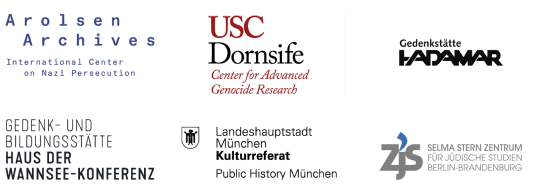Annotations
Kitzingen
March 1942
Two women are taken to the assembly point "Fränkischer Hof" on the back of a horse-drawn vehicle. A number of bystanders line up on both sides of the street along which the persecutees are driven.
Annotations
Keywords
4
Historical context
Deportation von Kitzingen nach Izbica am 24.03.1942
On March 19, 1942, more than 200 Jews from Mainfranken had to present themselves at the hotel “Fränkischer Hof” in Kitzingen. Here they had to stay and wait several days until they were deported to the Izbica ghetto via Nuremberg on March 24, 1942. The transport to Nuremberg had originally been scheduled for March 23, 1942.
The pertinent deportation order was issued in Nuremberg. The responsibility for the deportation lay in the hands of the Gestapo branch office in Würzburg, with its deputy director Michael Völkl playing the leading role.
None of the deportees were to survive: the people were either murdered in the Majdanek or Sobibor camps, or died as a result of the disastrous living conditions in the Izbica ghetto.
About the image series
The picture series comprises at least 52 photographs. Since the pictures were glued to file covers and preserved in an album format, there are no images of the pictures’ backs. The album includes photographs of three deportations that were implemented by the Gestapo branch office in Würzburg. What makes this series different from the other two series is that no captions have survived for the pictures from Kitzingen taken in March 1942. One part of the series is kept at Staatsarchiv Würzburg (Würzburg State Archives), another at the United States Holocaust Memorial Museum (USHMM). The pictures show the deportation process in Kitzingen: the arrival of the people at the assembly point, the forced march, the boarding of the train, and the loading of the luggage. The chronological order of the images cannot be reliably restored.
Photographer
Hermann Otto, senior criminal assistant
On instructions of the Nuremberg police chief, Dr. Martin, criminal assistant Hermann Otto kept a detailed photographic record of the deportations in the area of responsibility of the Würzburg Gestapo. Although criminal assistant Balthasar Lutz was also commissioned to photograph, only Hermann Otto took the pictures.
Hermann Otto, born in Würzburg in 1896, was a trained stone sculptor. He volunteered for the military in 1914 and joined the Bavarian State Police in 1922. Since 1938, he had been working for the Würzburg Gestapo. Starting from the summer of 1942, Hermann Otto was seconded to work in occupied Eastern Europe, his last post being with the security police in Belarus. He had been considered missing in action since June 27, 1944. In 1948, a denazification tribunal found him to be a “follower".
Provenance
The series is part of a photo album created by the Würzburg Gestapo that shows the deportations from Würzburg and Kitzingen in November 1941, March 1942, and April 1942. After its discovery by Isaac Wahler, a U.S. soldier who had been born in Nuremberg, the album was used as evidence in the Nuremberg trials and in the Eichmann trial. Copies of single photographs and of the entire album have survived in various archives. The whereabouts of the original album had been unclear for decades until historian Dr. Edith Raim recovered it in the early 2000s. Twenty-four of the original 28 file covers that make up the album are kept in Würzburg; the whereabouts of the other four are unclear. Nineteen images are copies from the United States Holocaust Memorial Museum (USHMM), which can be traced back to Isaac Wahler.
Call number at source archive
Photograph Number: 18894
Title at source archive
Two elderly Jewish women arrive at the Fränkischen Hof assembly center in a horse-drawn wagon during a deportation action in Kitzingen.
Acknowledgements
The present description is based on the volume "Wege in die Vernichtung. Die Deportation der Juden aus Mainfranken 1941 bis 1943” (Paths to Extinction. The Deportation of Jews from Mainfranken 1941 to 1943) published by the directorate general of the state archives in Bavaria. We would like to express our sincere thanks to Staatsarchiv Würzburg for the opportunity to inspect fonds 18880a in detail and for their support of the project.
Text and research by Alina Bothe.
Kooperationsverbund #LastSeen. Bilder der NS-Deportationen Dr. Alina Bothe Projektleiterin
c/o Selma Stern Zentrum für Jüdische Studien Berlin-Brandenburg
Freie Universität Berlin
Habelschwerdter Allee 34A
14195 Berlin
lastseen@zedat.fu-berlin.de
Ein Kooperationsprojekt von

Gefördert durch

Datenschutz | Impressum